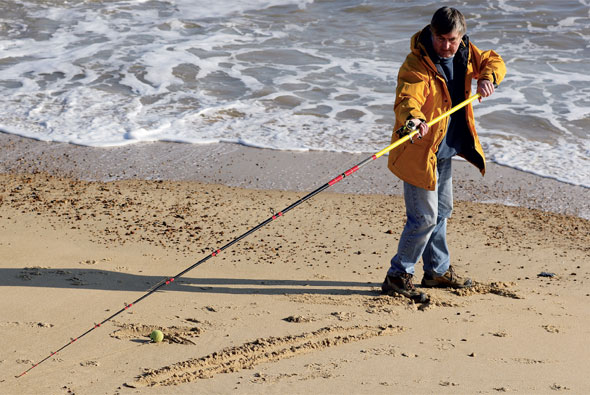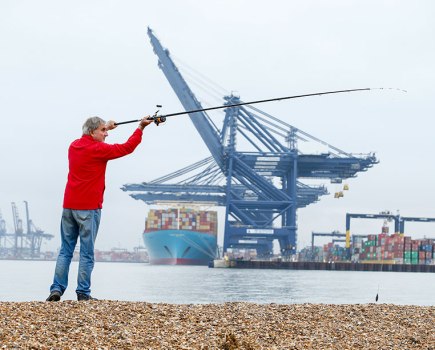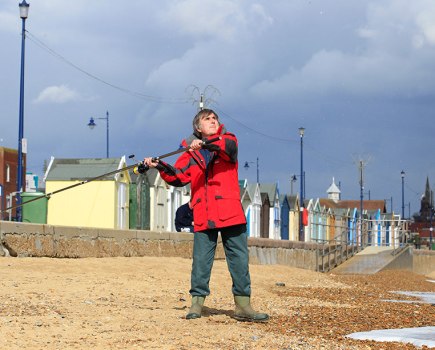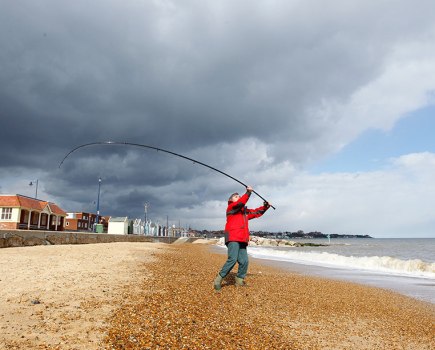In part two of our feature on beach casting, our casting coach and expert sea angler, John Holden, explains how you can cure off-ground headaches by aerialising the lead weight rather than laying it out on the ground.
The easy cast is simple, powerful and a good allrounder for most flat and sloping marks. The weight and rig normally lift from the ground with hardly any dragging. But like any off-ground cast it is of limited value or useless on weedy ground, rocks and in surf.
Another complaint is that ground casts do not handle clipped-down rigs very well. The moment the rig touches the ground the clips release the baits prematurely because the leader slackens. Experienced casters keep the lead on the move so that it barely touches the beach before being powered away. This useful trick still doesn’t address the issue of needing somewhere fairly clean and unrestricted to lay out the cast.
All of these headaches can be instantly cured by aerialising the weight rather than laying it out on the ground. This is not real pendulum casting, which even in compact form uses a generous out-swing and inswing to lift the lead weight well above head height before the power arc begins. Think of it as a re-positioning of the weight to a spot in mid-air just above its normal ground layout point.
Starting a cast with the lead in midair worries newcomers far more than it should. It must be difficult to control any aerialised method, surely? Well, yes and no.
It is necessary to co-ordinate the lead’s hovering at the peak of its inswing with the beginning of the main power arc. You need to watch the swinging lead carefully at first, but practise lets you feel the moment that the lead stops climbing.
Pressure on the rod tip falls slightly at that point, almost as if the lead has disappeared. For the experienced caster this feeling is the red ‘go’ signal that triggers the main part of the cast.
Learning to swing a lead is easier with a disciplined A,B,C sequence of outswing, inswing, cast. If anything goes wrong – no matter how little or how early – stop, then start all over again. Short drops cause more trouble than long ones, so if anything err towards a little extra. Longer drops slow the swing and make timing smoother; swing direction and height are easier to control.
Once you get the hang of swinging the lead accurately, you will be free to experiment further with drop length and angles to find the combination that gives smooth, easy power.
Confidence is at least as important as set-up and control. A less than perfect swing carried out with confidence outperforms perfect technique ruined by hesitation. Commit yourself.
Make the swing and then cast without worrying about the result. Accept that everyone makes lots of mistakes at first.
The setup
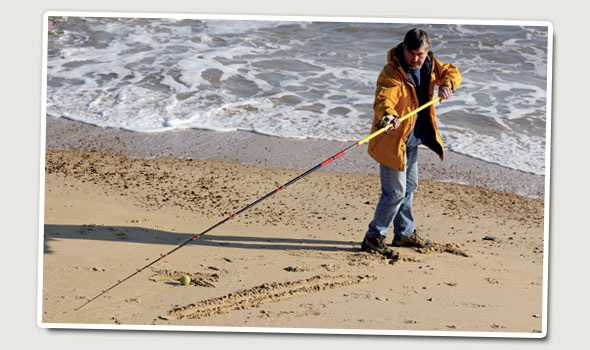
The new cast and the off-ground version share many key steps, including aerial target, stance, body rotation and rod angle. Run through the ground cast a few times to get yourself back in the groove. Marking foot and tackle layout positions is a good idea, so that you have some handy references from which to work.
The cast
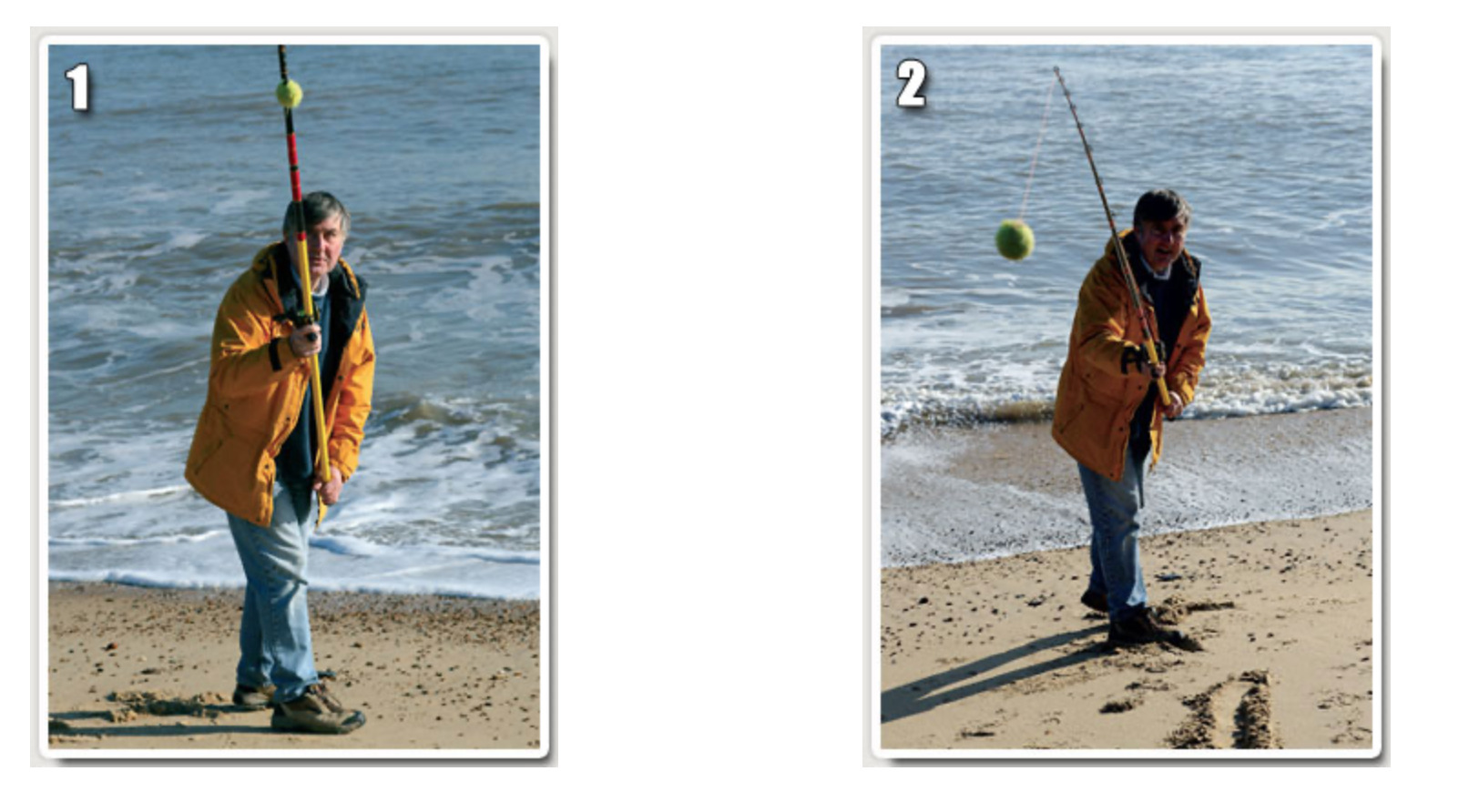
STEP 1
It may help to lay the sinker on the beach before lifting it into the start position, shown here. I’m using a lead drop of about half the rod length. Most beach rods including the long ones do well with 4-6ft of drop. Having prepared the reel, and pre-set my stance and body wind-up, I raise the rod tip until the lead hangs about 2ft from the blank, then push it away to begin the out-swing. The push is slow but purposeful.
STEP 2
I’ve aimed the out-swing to the right of the line on the sand that marked the off-ground rod angle. The lead tends to drift to the right of the rod, passing roughly over the original lead layout point. Aim somewhere in the general direction. I’m using a tennis ball to make this demonstration clearer, and you may find it helpful at first because it slows the flow and forces you to make a positive swing.
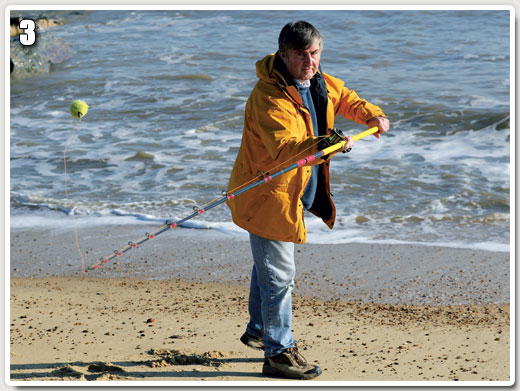
STEP 3
When the lead reaches suitable height on the out-swing – head height or a little below – push down with your left hand to reverse the action. The inswing naturally tends to steer itself to your right and well clear of the rod. Seen from above the caster, the rod angle on the inswing would be about the same as it was on the out-swing, both being roughly aligned with the mark on the beach.
Experts keep the swing low to maximise the rod’s power arc, but this demands perfect timing and swing control. For now, keep the inswing fairly high so that the lead peaks somewhere between waist and shoulder height. Just as the swing approaches its limit – and anticipating the hovering point can be tricky until you get used to it – smoothly and relatively slowly drop the rod tip by raising the butt cap with your left hand, as I’m doing in the photo.
The right hand can stay where it is. Its natural reaction is to drop a few inches, which is fine, but don’t push down deliberately. Drop the tip too low, and you risk driving the tip and/or the lead weight into the ground.
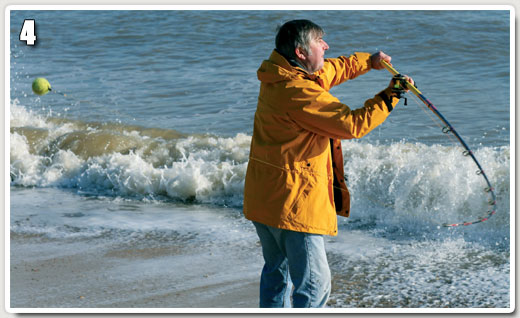
STEP 4
As your left hand rises, the rod tip begins to compress against the resistance of the lead which is now hovering in mid-air. Turn your head and focus on the target. Unwind your body then hammer the lead up into the air, exactly as in the off-ground style. The natural reaction is to bring the rod around much too quickly and fiercely in order to prevent the lead weight from hitting the ground. Strange though it seems, the best way to keep the lead airborne and on track is to slow right down.
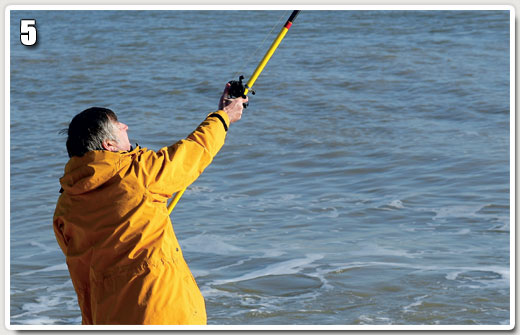
STEP 5
The follow through is the same as before except that you may notice that the rod has come through on a slightly shallower plane. This is a natural and correct response to the aerialised lead position, which makes the cast’s power arc flatter and slightly U-shaped compared to the off-ground cast’s more upright lift off and power stroke.
THINGS TO THINK ABOUT
Because of the changes to lead position, timing and power flow, the start of the aerialised cast will not feel the same as that of a ground cast.
Rod compression, for example, starts as early as it does in the offground version, but the feeling will be of a flatter launch that flows more around the body before veering towards the familiar, natural rod angle during the fi nal hammering action. These changes are subtle and best left to take care of themselves. Avoid side-arming the cast or forcing it towards the vertical, and the action will flow smoothly.
If swing control and timing are difficult, chances are that you are rushing, which is almost always due to lack of confidence. Slow down, relax, lengthen the drop a little, use a tennis ball if it helps, and above all remember that there is no rush to start the power stroke. A well positioned lead hovers for what seems ages, allowing a slow, steady start to the main part of the cast. The power flow itself should be about half as fast as most beginners imagine.
JOHN’S PROFESSIONAL TRICKS
Aerialised and pendulum casting styles tend to aggravate multiplier spool slip and backlashes. The reel may even twist on the rod handle. These annoyances tend to disappear when the style improves, but these tricks may help at first.
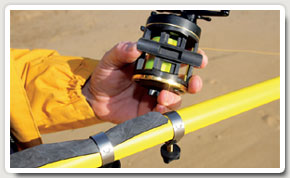
1. Cut a one-inch wide strip of inner tube and thread it under the coasters before attaching the reel, which should now be far less prone to any twisting out of place when the rod comes under pressure.
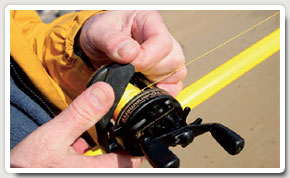
2. Sandwich the end of the rubber between your thumb and the spool for a slip-free grip and painless release. Trim the strip to extend just beyond your thumb when you grip the reel spool.

3. Suffer from backlash? Tighten the drag until you get a feel for the cast, then back it off to give the usual hint of free-play on the spool. If control is a problem, cast against a lightly set drag. Use your oldest reel, though!

